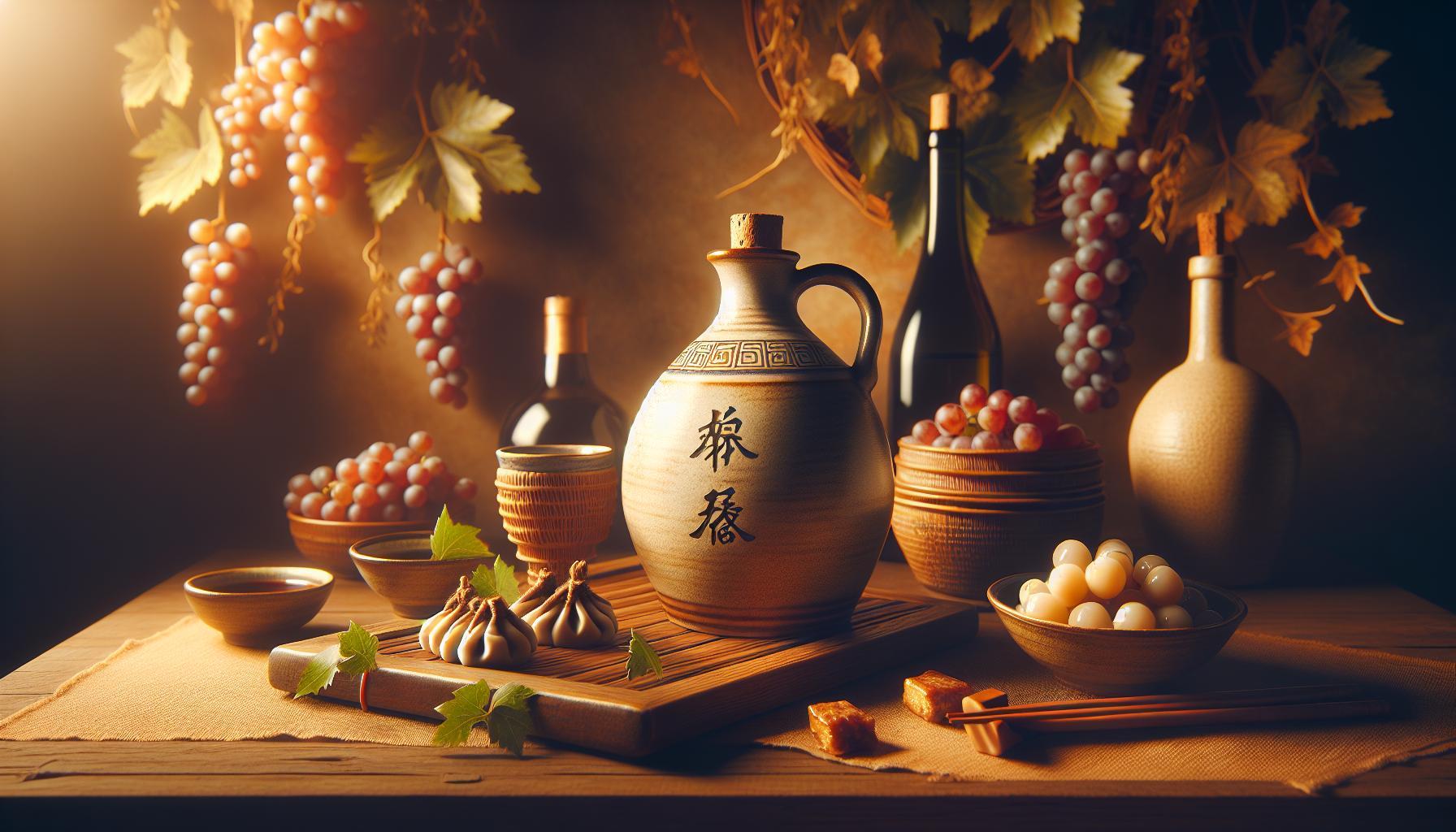Did you know that mead, often called honey wine, is one of the oldest fermented beverages known to humanity? This delightful elixir, made by fermenting honey with water and various flavorings, offers enthusiasts a unique tasting experience that can transport your palate through history and culture. Whether you’re a seasoned wine lover or simply curious about new flavors, discovering where to buy distinct bottles of mead can elevate your next gathering.
However, finding quality mead can sometimes feel like searching for hidden treasure. Perhaps you’re on a quest for that perfect bottle to impress at your next dinner party, or maybe you’re seeking a special gift that tells a story. This guide will delve into local and online sources where you can uncover unique mead offerings near you, ensuring both satisfaction and discovery as you embark on this delightful journey. Join us as we explore the art of sourcing mead, allowing you to fully savor its rich flavors and the human connections that come along with each bottle.
Where to Find Local Mead Honey Wine Retailers
When embarking on a quest for mead, honey wine enthusiasts might be surprised to discover the burgeoning number of local retailers and producers eager to share their exquisite brews. Mead, a beverage steeped in history and tradition, has seen a renaissance in recent years, leading to a proliferation of meaderies ready to craft unique flavors and styles that tantalize the palate. Whether you are a seasoned mead aficionado or a curious novice, finding local mead retailers can be more of an adventure than a chore-each visit offering a glimpse into the rich tapestry of this ancient beverage.
Begin your journey by exploring your local specialty liquor stores, which are increasingly dedicating sections to artisanal beverages. Many have recognized a rising demand for mead and take pride in curating selections that showcase both well-known and obscure brands. Always ask the staff for their recommendations; they can provide invaluable insights into the regional producers and hidden gems that might not yet have made it to the mainstream spotlight. A personal touch, perhaps accompanied by a brief history or tasting notes, can transform a simple purchase into a delightful exploration of flavors and stories that enrich your understanding of mead.
Another excellent resource is local farm markets or craft fairs, where mead makers often set up stalls to share the fruits of their labor directly with the community. Here, you can engage with the artisans behind the bottles, learn about their production processes, and discover how local flora influences their unique varietals. The vibrancy of a market filled with passionate producers creates an atmosphere that allows for deeper appreciation-not only of the mead itself but also of the craftsmanship involved in creating these liquid histories.
Lastly, consider joining mead tasting groups or local wine clubs, where enthusiasts gather to share their experiences. These communities often host tastings or visits to meaderies, providing an opportunity to interact with fellow lovers of honey wine. In these spaces, you can swap recommendations and discover previously unknown places to find that perfect bottle or try a rare varietal, expanding your palate and knowledge simultaneously.
In engaging with these local resources, you embrace not only the art of mead but also the connections forged through shared experiences and stories-because, after all, every sip of mead carries with it a narrative worth exploring.
Exploring Unique Mead Varietals and Flavors

Mead, often referred to as the “nectar of the gods,” delights with its diverse range of varietals and flavors, transcending the mere act of drinking into an exploration of history, culture, and artistry. Each sip tells a story, one shaped by the myriad ingredients used, the methods employed by the mead maker, and the terroir from which the honey originates. In your search for unique bottles, understanding the fascinating spectrum of mead is essential.
As you delve into your local mead selections, consider the various types of honey used in production. Different flowers yield distinct flavors and aromas, transforming the mead into something reflective of local flora. For instance, wildflower honey often results in a complex flavor profile, marrying floral notes with hints of spice, while clover honey produces a more delicate and sweet mead that appeals to first-time drinkers. Moreover, adventurous meaderies are experimenting with unique and sometimes unexpected additions, such as spices, fruits, and herbs. Mead infused with raspberries or chai spices tells a different story, drawing flavors into a medley that enchants both the nose and palate.
Taste is subjective, and exploring unique varietals allows for the magic of personal discovery. When you encounter melomels, which are fruit meads that might incorporate anything from blueberries to peaches, approach them with an open mind and a readiness to loosely categorize flavors. Similarly, metheglins, infused with spices or herbs, can unveil an entirely different sensory experience. Imagine a mead laced with cinnamon and clove, evoking the warmth of a cozy evening by the fireplace, or one that mingles with fresh aromatic herbs, beckoning visions of sun-drenched summer picnics.
To fully appreciate the nuances of mead-and to find those hidden gems in your local retailers-embark on tasting journeys at meaderies or mead festivals. Here, you can sample a range of offerings, guided by passionate artisans eager to share not just their creations but also the stories behind them. Discuss your findings with fellow enthusiasts; the camaraderie can introduce you to remarkable discoveries, enriching your perspective on this ancient alcoholic beverage. Remember that while mead can often be classified into categories, the enchantment lies in how each bottle reflects its maker’s passion and the unique interplay of ingredients, ensuring that there’s always something new and exciting to taste.
Thus, exploration becomes more than just a means to find a unique bottle; it acts as a gateway into a community, a history, and a shared joy that transforms simple enjoyment into a deeper understanding and appreciation for the world of mead.
The Art of Selecting Quality Mead: What to Look For

Selecting quality mead can feel akin to embarking on a delicious adventure, a dive into the rich tapestry of flavors that each bottle promises. With a heritage woven through centuries and cultures, mead is more than just an alcoholic beverage; it is a narrative waiting to be savored. As you venture into local retailers in search of unique bottles, honing your senses for quality can transform your exploration into an enriching experience.
Start by paying attention to the appearance of the mead. A good mead should have clarity and brilliance, free of any sediment or cloudiness, unless it’s a deliberately crafted style that incorporates such textures. When held to the light, it should reveal depth and shine, hinting at the care taken in its production. The color can also be an indicator of its character-ranging from pale gold to deep, dark amber. Take a moment to appreciate this visual aspect; it is the first story your mead tells.
Next comes the aroma. When you gently swirl your glass and inhale, allow the complex notes to wash over you. Is there a bold floral scent, or perhaps ripe fruit notes? High-quality mead often showcases the essence of its honey source and any additional ingredients used. For example, a mead made from wildflower honey may present a bouquet of flowers, herbs, and spices, while a melomel with raspberry could offer tart, fresh berry aromas. This sensory exploration gives you a preview of the flavor journey awaiting you.
The taste experience is where your adventure truly unfolds. As you take your first sip, consider the balance of sweetness and acidity-a hallmark of a well-crafted mead. While sweetness is a natural characteristic of honey, a quality mead will find harmony with its acidity, allowing the flavors to shine rather than overwhelm. Notes to look for include the subtlety of honey, the complexity of any added fruits, and the warmth of spices. If you find yourself lingering over a particular bottle, considering its structure and finish can reveal much about its quality; a smooth finish often denotes skillful crafting and thoughtful aging.
Finally, don’t overlook the importance of the story behind the bottle. Engaging with local meadmakers can enhance your appreciation and connection to the mead. Ask about their sourcing practices for honey, their fermentation methods, and any unique techniques they employ in creating their craft. As a sober inquirer, your interest in these details can be rewarding; it deepens your understanding of the culture and artistry involved in mead production, transforming your tasting into a shared celebration of history and community.
To summarize, as you navigate your journey through local meaderies and retailers, balance the visual, aromatic, and gustatory aspects of mead with the enchanting tales behind the bottle, amplifying your exploration and enjoyment of this ancient nectar.
Taste the History: The Cultural Significance of Mead
The roots of mead stretch back thousands of years, entwined with the stories of human civilization, cultures, and traditions. Historically known as the “nectar of the gods,” mead has served not only as a celebratory drink but also as a profound cultural symbol across various societies. From the Viking feasts to ancient Greek ceremonies, mead has shaped communal gatherings, signifying fertility, celebration, and even divinity. When you sip this golden elixir, you’re not merely tasting honey fermented with water and yeast; you’re drinking in history, tradition, and the collective experiences of communities long past.
Mead’s cultural significance is perhaps most prominently displayed in its role during rites of passage. In many cultures, it is believed that toasting with mead at weddings brings prosperity and fertility to the newlyweds. In fact, the term “honeymoon” is said to stem from the tradition of giving couples mead for a month after their wedding to ensure a fruitful union. Similarly, in Celtic folklore, mead is closely linked with inspiration and creativity, often consumed by poets and bards before they shared their art. These rituals highlight mead’s dual role as a celebratory beverage and a conduit for cultural expression.
You might wonder where to find these storied brews today. Fortunately, local meaderies have sprung up across the globe, rekindling ancient traditions with modern twists. Seek out smaller, artisan producers who focus on traditional methods. These meaderies often honor heritage recipes, using local honey and foraged ingredients that reflect their regional tastes and seasons. When you visit a local meadery or retailer, engage with the meadmakers-ask about their inspiration and the stories behind their distinct varietals. You may uncover a bottle that not only appeals to your palate but also connects you to the exciting narrative of how that mead came to be.
As you explore, consider tasting meads that showcase specific ingredients tied to their culture-whether it’s a traditional melomel made with heirloom apples steeped in your region’s folklore or a spiced metheglin that echoes centuries-old recipes. Sampling a wide range of these unique offerings can enhance your appreciation for how mead has served as a vessel for storytelling across eras and lands. So, as you embark on your quest to find remarkable meads near you, remember that each sip is an invitation to engage with the past, celebrating the interplay of culture, community, and artistry in this timeless drink.
Hidden Gems: Small-Batch Mead Makers to Discover
Exploring the world of mead is akin to embarking on a treasure hunt, where hidden gems sparkle brightly amidst the sprawling landscape of established beverages. Small-batch mead makers are often the unsung heroes of this ancient craft, infusing their creations with personal stories and local ingredients. These artisan producers are dedicated to preserving traditional methods while adding new flavors and flair, and their offerings promise a delightful exploration of mead’s diverse character.
When you step into the realm of small-batch meaderies, you step into stories etched in honey and crafted with passion. These producers range from cozy family-run establishments to innovative new ventures, often located in verdant countryside or artisan districts. Here, the air is infused with the scent of local flora, the bees buzz tirelessly, and every bottle tells a story. Imagine sipping a mead made from wildflowers carefully handpicked from the meadery’s nearby fields, or one that features exotic spices reminiscent of a vibrant market halfway across the world.
To help you on your quest, consider these standout small-batch mead makers:
- The Honey House: Nestled in the heart of the Appalachian region, The Honey House prides itself on using foraged wildflowers to create their meads. Their Wildflower Melomel is an aromatic feast of floral and fruity notes that dances on the palate, offering a unique taste of the local landscape.
- Bee’s Knees: Located in a historic town where craftsmanship reigns, Bee’s Knees produces small quantities of artisanal mead that explore unusual flavor profiles, such as cardamom or hibiscus-infused varietals. Their adventurous spirit invites enthusiasts to experience mead in a whole new light.
- Moonlit Meadows: Famous for their seasonal meads, Moonlit Meadows crafts blends that reflect the sun-kissed fruits harvested throughout the year. Their Autumn Harvest Mead, infused with ripe apples and a hint of cinnamon, evokes the comforting flavors of fall.
When visiting these meaderies, engage with the meadmakers. Their passion is infectious, and they often love to share insights about their craft, from the sourcing of ingredients to fermentation techniques. This connection deepens your appreciation of each sip, transforming wine tasting into a rich sensory experience that transcends the beverage itself.
As you immerse yourself in these hidden gems, be open to the unexpected; the magical essence of small-batch mead lies in its ability to surprise and delight. With every bottle, you’re not only enjoying a unique flavor but also connecting with the artistry and heart that defines the burgeoning community of mead enthusiasts. Remember, the search for exceptional mead is not just about the drink-it’s about understanding the harmony of nature, culture, and interconnected stories that each pour encapsulates.
Pairing Mead with Food: Perfect Matches for Every Occasion
Imagine sinking into a cozy dinner setting, the ambient lighting casting a warm glow, and as the aroma of a delicious meal wafts through the air, a beautifully chilled glass of mead awaits beside your plate. This harmonious pairing can elevate a meal from merely enjoyable to an enchanting culinary experience, revealing the diverse nature of mead and its ability to complement a variety of dishes. With its varied profiles-ranging from floral and fruity to herbal and spicy-mead invites exploration, much like the journey of discovering unique bottles at your local mead honey wine retailers.
Pairing Notes for Your Mead Selection
To embark on this flavorful adventure, consider the base ingredients of your mead and how they can harmonize with your meal. Here are some delightful pairings to ignite your imagination:
- Fruity Meads: These are perfect companions for light salads, grilled chicken, or seafood dishes. For instance, a bright peach melomel beautifully complements a lightly dressed arugula salad with goat cheese and candied pecans, while a berry mead can enhance the flavors of a grilled salmon topped with a raspberry glaze.
- Herbal and Spiced Meads: Infusion of herbs like thyme, rosemary, or spices like ginger offers a perfect match for heartier fare. A ginger mead pairs wonderfully with Asian-inspired dishes like teriyaki chicken or even spicy Thai curries, while a mead infused with lavender might find a home alongside roasted vegetables, enhancing their earthy flavors.
- Traditional or Dry Meads: The crispness of these meads can be a revelation when paired with cheese boards or charcuterie. A dry mead, with its clean finish, complements aged cheeses such as sharp cheddar or brie, while artisanal meats can bring out the rich undertones of the mead, creating a lovely interplay of flavors on your palate.
Celebrating Occasions with Mead
Mead isn’t just for everyday meals; its versatility extends to special gatherings and celebrations. At festive moments, adventurous pairings can create unforgettable dining experiences. For intimate dinners, consider matching a seasonal mead-for example, a pumpkin spiced mead-with a Thanksgiving feast that features roasted turkey and savory stuffing, letting the spices echo the warmth of the season. Alternatively, for summer barbecues, a refreshing honey lavender mead can elevate grilled corn and BBQ ribs, providing a sweet counterpoint to smoky flavors.
Much like crafting a tailored wine list, exploring mead pairings can become a delightful journey. Allow yourself the joy of experimentation-each bottle reveals a unique narrative waiting to be shared at the table. As you engage in these pairings, remember that the magic often lies not just in the chemistry of flavor but in the stories shared over each sip and bite, transforming mealtime into a memorable experience steeped in taste and connection. Whether it’s a quiet evening at home or an elaborate feast, there’s a mead waiting to be discovered that complements not just your meal, but the very essence of the occasion.
Understanding Mead Production: From Honey to Bottle
Did you know that the journey of mead-from the humble bee-harvested nectar to the glass you savor-is an intricate dance of nature, tradition, and skill? Mead’s production process is not merely about fermentation; it’s a reflection of culture and history, linking us back to the ancient civilizations that revered this honey wine. Understanding how mead is crafted can enhance your appreciation for each bottle, especially when you find unique selections at local retailers.
The journey begins with honey, which is the cornerstone of any mead. The floral notes vary depending on the source of the nectar; for instance, wildflower honey may impart a different taste profile than clover honey. Mead makers often choose their honey based on flavor characteristics and the intended style of the final product. As the honey is combined with water, the mixture, referred to as the must, sets the stage for fermentation. Here’s where the magic truly happens: yeast is introduced to the must, converting the sugars found in honey into alcohol and carbon dioxide. This fermentation process, which can last from a few weeks to several months, is monitored closely, as the environment (temperature, yeast strain, etc.) significantly influences the outcome.
The Role of Ingredients and Techniques
Beyond honey and water, mead can embrace a multitude of flavors through the addition of fruits, spices, and herbs. This variation creates a tapestry of styles, from fruity melomels to spiced metheglins. Some meaderies even experiment with barrel-aging, imbuing the final product with layers of complexity, akin to fine wines. For instance, the best meaderies understand terroir, recognizing how the local climate and soil influence not just the grapes in wine but also the flowers that bees forage. This connection to place is what elevates certain meads from the ordinary to extraordinary.
Once fermentation is complete, the mead undergoes a careful aging process, allowing the flavors to develop and mellow. During this period, the mead maker may decide to filter and possibly carbonate the mead, leading to variations in mouthfeel and texture. Finally, after bottling, the mead is ready to make its debut. Whether it’s a rustic bottle or an intricately designed label, each presentation signifies not just a beverage, but a story-a snapshot of the dedicated craftsmanship and passion that went into its creation.
As you embark on your quest to find local mead honey wine retailers, remember that each bottle holds within it the essence of the flowers that fed the bees, the expertise of the mead maker, and the traditions of cultures long past. By understanding the production process, you further enrich your tasting experience, cultivating a deeper connection with this ancient, yet ever-evolving, beverage.
Events and Festivals: Experience Mead Culture Live
A vibrant tapestry of flavors and history awaits at mead festivals and events across the globe, celebrating the ancient art of honey wine production while fostering community and connection. Imagine stepping into a bustling venue adorned with booths overflowing with bottles of mead-each one telling a tale of its own as you converse with passionate artisans keen to share their craft. These gatherings offer more than just tasting; they provide an immersive experience of mead culture that echoes the spirit of conviviality.
Taking part in a mead festival often invites you to explore an array of varietals, from traditional braggots to innovative fruit and spice blends. Consider attending the renowned Mead Festival in Denver, Colorado, where participants can taste over 50 different meads from local and national producers. Here, the joy of discovery is amplified as you chat with mead makers, learning about their unique production techniques and flavor inspirations. These events often feature educational sessions where you can dive deeper into the intricacies of mead-making, discussing topics such as the effects of fermentation techniques on flavor complexity or how local flora can shape the character of the honey used.
Building Community and Culture
Many mead festivals take on a community-focused approach, blending local food vendors and live music with the tasting experience. This intermingling of arts and gastronomy not only celebrates mead but also creates an atmosphere of shared passion and enjoyment. Picture yourself enjoying a glass of honey wine while savoring artisanal cheeses and locally sourced charcuterie, all while listening to spirited folk music-a perfect harmony of flavors, culture, and camaraderie.
As you go about your adventure, don’t shy away from participating in mead tastings and workshops. Engaging in tasting flights allows you to compare meads side by side, honing your palate and understanding the nuances of each style. Consider taking notes on the aroma, flavor profiles, and mouthfeel, crafting your preferences as you curate a wishlist of unique bottles to seek out at local retailers once the festival concludes.
Events to Mark on Your Calendar
Here’s a brief list of notable events that consistently capture the essence of mead culture:
- Mead Day – Celebrated annually in August, this day encourages homebrewers and enthusiasts to make mead and share their creations.
- International Mead Festival – Held in various locations each year, it showcases global mead varieties and educates attendees on local traditions.
- National Honey Wine Festival – A gathering of mead lovers from all walks of life that takes place in different cities, offering tastings, classes, and mead-infused delicacies.
By immersing yourself in these vibrant celebrations, you not only cultivate your appreciation for mead but also contribute to the growing community surrounding this delightful beverage. Each event is a window into the world of mead, allowing you to experience firsthand the joys of this age-old libation while connecting with those who share your newfound passion. As you stroll among the stalls, glass in hand, you may just find that your experience transcends taste, weaving together the stories of the makers, the flowers, and the age-old traditions that bring each bottle to life.
Ordering Mead Online: Best Options and Tips
In the ever-expanding landscape of mead appreciation, ordering online opens a treasure trove of unique varietals that might be elusive in your local shops. Whether you’re a seasoned mead aficionado or a curious novice, exploring the depths of online mead retailers can be akin to wandering through a fragrant meadow, ripe with possibilities. With an array of options available at your fingertips, careful selection is key to ensuring that you bring home bottles bursting with character and quality.
When navigating the digital marketplace for mead, it’s beneficial to start with established online platforms dedicated to honey wine. Websites like Meadery.com or CraftMead.com curate selections from various meaderies, allowing you to taste meads from across the country or even the globe without leaving the comfort of your home. Many of these sites offer user-friendly filters, such as flavor profiles, ingredients, and production methods, letting you tailor your search to match your palate, whether you’re drawn to floral notes or spicy undertones.
Tips for Successful Online Mead Shopping
To maximize your online mead shopping experience, consider these practical tips:
- Check Shipping Restrictions: Each state has its own rules regarding the shipment of alcoholic beverages. Before placing an order, make sure your state allows mead deliveries and take note of any potential shipping costs or delays.
- Read Reviews: Online reviews can be invaluable. Check for notes on flavor profiles and quality from fellow mead enthusiasts to guide your selections. Websites often feature customer ratings and testimonials that provide insight beyond the tasting notes provided by the seller.
- Explore Subscription Services: If you find joy in the journey of discovery, consider signing up for mead subscription boxes. Services like MeadCrate deliver curated selections right to your door, often featuring small-batch, artisanal meads you might otherwise miss out on.
- Learn About the Producer: Many retailers provide background information about the meadery, including their production methods and philosophy. Familiarizing yourself with these details can enhance your appreciation of the mead, transforming each bottle into a narrative experience that resonates with the story of its origin.
Another fascinating approach is to engage with meaderies through social media platforms. Many producers share limited releases or special offers directly with their followers, fostering a sense of community that can lead to exclusive finds. Furthermore, platforms like Instagram allow you to peek behind the scenes, where you can connect directly with the creators, enhancing your appreciation for the craftsmanship behind each bottle.
Finally, remember that mead, with its ancient roots and diverse expressions, is a conversation starter. Share your discoveries with fellow enthusiasts, whether in person or in online forums, as this communal aspect enriches the pleasure of each sip you take. Every online order becomes part of your own mead journey, weaving together stories and flavors that invite you to savor not just the drink itself but the culture that surrounds it. Happy tasting!
Mead Education: Resources for Beginners and Enthusiasts
In a world where the subtleties of flavor can transport you through time and culture, understanding mead offers an exciting journey for both newcomers and seasoned connoisseurs alike. This ancient nectar, born from the union of honey and water, occasionally intertwined with fruits, spices, or grains, invites exploration into its diverse landscapes-from the effervescent to the still, and from the dry to the luxurious sweetness of dessert meads. Yet, as you start your mead adventure, it’s vital to equip yourself with the right knowledge and resources to truly appreciate this enchanting beverage.
For those beginning to navigate the mead universe, picking up a few foundational texts can illuminate the fascinating intricacies of mead production and tasting. Consider diving into “The Complete Idiot’s Guide to Mead Making” by Michael Fairbrother, which demystifies the brewing process with clear, engaging steps for crafting your mead at home. Pair such literature with blogs like “Got Mead?”-a vibrant community resource packed with articles, recipes, and forums where enthusiasts share their experiences and tips. Immerse yourself in the culture further by listening to podcasts such as “Meadcast,” where industry experts and passionate hobbyists delve into topics that span from fermentation science to cider and honey sourcing.
Local meaderies often serve as a treasure trove of knowledge as well. Many facilities welcome visitors with open arms for tastings and tours, where you can learn firsthand about their production techniques and the local ingredients that shape their meads. Engaging in these experiences not only hones your palate but also connects you with the roots of mead-making, creating a narrative depth to each bottle you subsequently seek out. Don’t miss their events either; meaderies frequently host workshops and meet-the-maker evenings that can enhance your understanding and appreciation of this honeyed libation.
As you satiate your curiosity, remember to embrace the art of tasting. When sampling, take a moment to engage your senses-notice the aroma first, allowing your mind to wander through fields of blooming wildflowers or freshly zested citrus. Observe the color, which can tell a story of its own, from bright amber to deep mahogany. Finally, allow the mead to rest on your palate, noting the layering of flavors. Is it sweet? Spicy? Does it evoke the warmth of the sun on a summer afternoon? Each sip is a conversation between you and the maker, a shared moment that transforms mere tasting into a celebration of connection-historic, cultural, and personal.
Ultimately, the world of mead is one where every bottle carries a story and an invitation to explore further. So equip yourself with resources, engage with others, visit meaderies, and revel in the rich tapestry that each unique varietal offers. As you deepen your understanding and appreciation for this remarkable beverage, you may find that mead serves not only as a drink but as a passport to adventure and a new community of kindred spirits who, like you, are enamored by this age-old art of honey wine.
Sustainable Mead: Exploring Eco-Friendly Practices in Production
In an age where sustainable practices are increasingly paramount, the world of mead production is finding its own unique way to contribute to ecological preservation. The alchemy of honey, water, and sometimes fruits, spices, or grains offers an exciting opportunity to engage with nature, and many meaderies are stepping up their eco-friendly practices to ensure that the art of mead-making harmonizes with the environment.
One of the most tangible aspects of sustainable mead production is the sourcing of honey. Local beekeeping not only supports local ecosystems but also encourages biodiversity. Many meaderies prioritize partnerships with local beekeepers, ensuring that the honey used in their melomels and metheglins comes from hives maintained with care for the surrounding environment. This practice not only guarantees freshness but also helps preserve the health of bee populations critical for pollination. Moreover, opting for wildflower honey can enhance the flavor profile of the mead, infusing it with the essence of the region’s flora.
In addition to responsible sourcing, numerous producers are embracing organic farming practices. By eschewing synthetic pesticides and fertilizers, these meaderies create harmonious ecosystems that nurture both the bees and the plants from which the ingredients are derived. As a consumer, you can look for labels indicating organic certification, which serves as a safeguard of quality and sustainability. The creative use of sustainable materials extends to the bottling and packaging process, where options like recycled glass and biodegradable labels are becoming more prevalent, allowing you to enjoy your mead while minimizing your environmental footprint.
Consider the meditation of flavor that comes with each sip of sustainably produced mead. The meticulous attention to environmentally friendly practices not only enhances the quality of the honey wine itself but also enriches the story behind every bottle. When you choose to purchase mead from a producer committed to sustainability, you inadvertently join a movement that celebrates the fluid relationship between quality craftsmanship and ecological stewardship. Whether it’s a refreshing session mead crafted from local wildflower honey or a rich traditional mead seasoned with organic spices, every choice you make echoes through the intricate chain of care and consideration that supports our planet.
So, as you embark on your mead-tasting journey, keep an eye out for those producers who are weaving sustainability into their craft. You’ll not only discover unique bottles that tantalize your palate but also connect with a community of creators intent on making the world a better place-one delicious sip at a time.
Mead Cocktails: Creative Ways to Enjoy Honey Wine
There’s a world of creativity waiting just beyond the bottle when it comes to enjoying honey wine. Utilizing mead as a base for cocktails not only enhances its flavors but also allows you to explore the spectrum of textures and aromas that this ancient elixir can offer. Think of mead not as a drink confined to traditional pairings, but as a versatile canvas ready to embrace a medley of ingredients that dance harmoniously around its sweet, floral essence.
Mead Mule: A Refreshing Twist
The classic Moscow Mule is a perfect gateway cocktail to explore. By swapping out vodka for sparkling mead, you create a delightful version of this refreshing drink that honors the character of both its components. Combine:
- 2 oz of sparkling mead
- 1 oz of fresh lime juice
- Ginger beer to top
Mix these ingredients in a chilled copper mug filled with ice, then garnish with a sprig of mint and a lime wedge for that extra pop of color and aroma. The effervescence of the mead mingles beautifully with the spicy notes of ginger, creating a crisp delight that’s perfect for summer afternoons or festive gatherings.
Floral Fizz: Celebrate the Seasons
For those inclined toward a more delicate flavor profile, the Floral Fizz showcases the natural floral notes inherent in many meads. Blend:
- 1.5 oz of a floral mead (think chamomile or elderflower)
- 1 oz of fresh grapefruit juice
- Top with soda water
Shake the mead and grapefruit juice with ice, then strain into a tall glass filled with fresh ice and top with soda. This cocktail is not only visually stunning but also embodies the brightness of spring and summer. Garnish with a grapefruit twist or edible flowers to amplify its charm.
Spiced Mead Old Fashioned: A Cozy Classic Reinvented
For cooler evenings, try your hand at a spiced mead old fashioned. This cocktail marries the warmth of traditional spices within the framework of a timeless classic. You’ll need:
- 2 oz of a spiced mead (preferably with hints of cinnamon and cloves)
- 1 sugar cube
- 2 dashes of aromatic bitters
Muddle the sugar cube with bitters in an old-fashioned glass, then add a large ice cube and pour the spiced mead over the top. Stir gently to combine and express the oils of an orange peel over the drink before adding it as garnish. This cocktail not only warms the palate but also conjures images of crackling fires and cozy gatherings, evoking the communal warmth that mead has historically provided.
Embracing these creative interpretations of mead doesn’t merely elevate the drinking experience; it encapsulates the joy of exploration and indulgence. Each cocktail becomes a reflection of your unique taste, shaped by the milieu in which you find yourself. As you seek out local mead retailers, look not just for unique bottles but for opportunities to craft something extraordinary with every pour. The art of mixing mead is a celebration of flavor, nostalgia, and, most importantly, connection. Whether it’s a gathering of friends or a serene moment of self-reflection, the cocktails you create will undoubtedly inspire conversations that linger long after the last sip.
Faq
Q: Where can I buy mead honey wine locally?
A: You can buy mead honey wine at specialized liquor stores, local breweries, or meaderies. Use apps like Untappd or Google Maps to find meaderies near you. For the best selection, explore farmer’s markets, craft fairs, and wine festivals that often feature unique local crafts.
Q: What is the best way to find unique mead flavors?
A: To discover unique mead flavors, visit local meaderies or artisanal liquor stores that carry craft selections. Online marketplaces like Etsy or specialty retailers often offer exotic and limited-edition options. Don’t hesitate to ask the staff for recommendations based on your palate preferences for a more personalized experience.
Q: How can I order mead honey wine online?
A: You can order mead honey wine online through reputable wine shops like Drizly or local meaderies that provide shipping services. Always check for age restrictions and shipping policies in your area to ensure a smooth purchasing process.
Q: What should I consider when buying mead honey wine?
A: When buying mead honey wine, consider the type (traditional, hydromel, melomel), flavor profile, and alcohol content. Pay attention to the ingredients to align with your taste preferences. Reading reviews and asking for staff insights can also help guide your selection towards a delightful choice.
Q: Are there meaderies that offer tasting events?
A: Yes, many meaderies offer tasting events, which are fantastic for experiencing different varieties. Check their websites for event schedules and appointments. Participating in tastings can expand your palate and connect you with the mead-making community.
Q: What are some popular mead honey wine brands to look for?
A: Popular mead honey wine brands include Honeyrun, Viking Blod, and Redstone Meadery. These brands emphasize quality and offer diverse flavor profiles. Exploring their offerings at local retailers or online can help you find something special that resonates with your taste.
Q: Can I find mead honey wine at local farmers’ markets?
A: Yes, many farmers’ markets feature local mead producers who sell their honey wines. This is a great way to support small businesses while discovering unique flavors. Visit your local farmers’ market’s website for vendor lists to locate mead sellers.
Q: How do I approach tasting mead honey wine?
A: Begin by examining the color and clarity, then inhale the aromas before tasting. Savor the flavors, noting the sweetness from honey and any added fruits or spices. Taking your time allows you to appreciate the complexities of mead, turning each sip into an exploration of its rich heritage.
Engaging with regional mead culture enriches your experience-so whether you’re a seasoned connoisseur or new to the realm of honey wine, dive deeper into mead’s fascinating world and let each bottle tell you its story. For further exploration, check our main article on choosing the perfect mead for more tips and recommendations.
To Wrap It Up
As you embark on your journey to discover the enchanting world of mead honey wine, remember that each unique bottle holds not only alluring flavors but also stories of tradition and craft. Whether you seek local artisans or expansive online selections, the quest for the perfect mead is a blend of adventure and delight. Don’t let hesitation keep you from that spark of inspiration-explore your nearby wine shops or specialty vendors today.
For those curious to deepen their appreciation, dive into our guides on “The History of Mead” and “Tasting Notes: The Art of Savoring Wine.” Each post unveils more about this historic beverage, enriching your understanding and enjoyment. And if you’d like to keep the conversation going, consider signing up for our newsletter, where we share exclusive tastings, events, and mead experiences.
The accolades for mead are flowing, and now is the time to take part in this revitalized passion for an ancient drink. Engage with fellow mead enthusiasts in the comments below and let us know your favorite finds! Your palate’s next adventure awaits-embrace it wholeheartedly.





